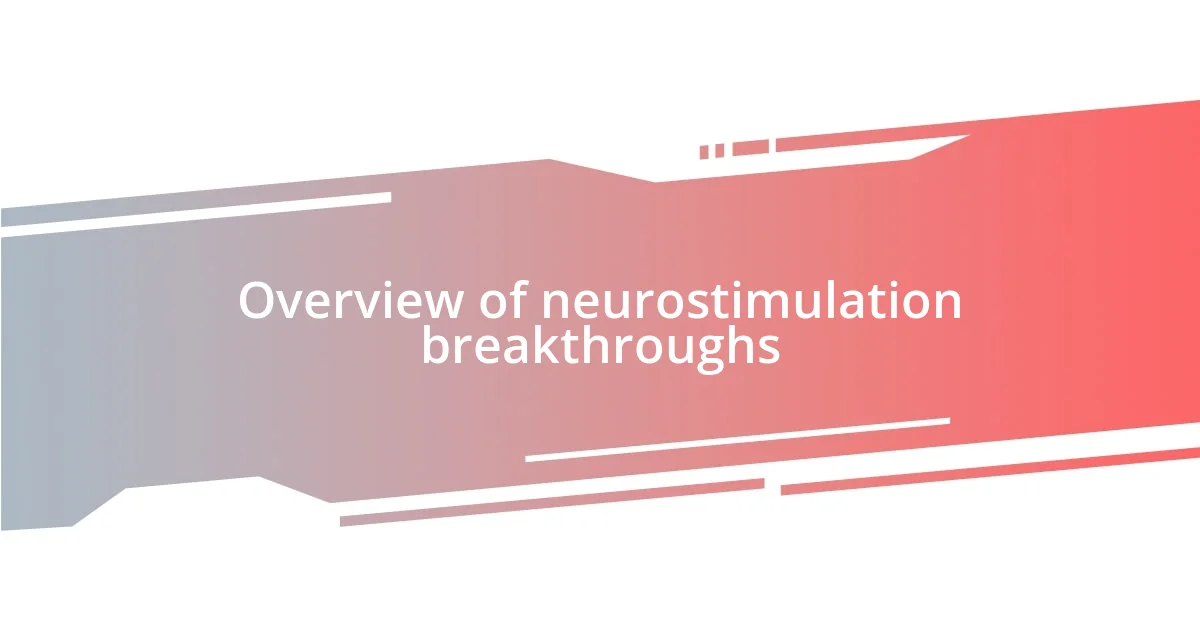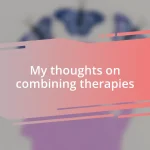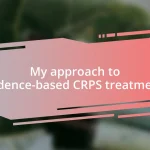Key takeaways:
- Neurostimulation techniques like Deep Brain Stimulation (DBS) and Transcranial Magnetic Stimulation (TMS) show significant promise in treating various neurological and mental health conditions, enhancing the quality of life for patients.
- Emerging technologies such as closed-loop systems and wearable neurostimulation devices are revolutionizing individualized treatment approaches, empowering patients to engage actively in their healing processes.
- Challenges remain, including variability in patient responses, financial burdens, and the need for deeper understanding of brain networks, highlighting the importance of ongoing research and accessibility in neurostimulation therapies.

Overview of neurostimulation breakthroughs
Neurostimulation breakthroughs represent an exciting frontier in both medicine and neuroscience. These advancements, which include deep brain stimulation (DBS) and transcranial magnetic stimulation (TMS), have shown remarkable potential in treating conditions like Parkinson’s disease, chronic pain, and even depression. I remember a time when a friend shared how TMS helped lift the heaviness of her depression; it was an emotional moment witnessing her transformation.
One of the most fascinating aspects of these breakthroughs is their ability to target specific brain regions. This precision not only improves treatment effectiveness but also minimizes side effects. Isn’t it incredible how manipulating electrical signals can lead to substantial changes in our mental health? My experience in the field has shown that the right neurostimulation technique can turn the tide for many individuals who have struggled for years without relief.
Moreover, the future of neurostimulation holds even more promise. Emerging technologies, like closed-loop systems that adjust stimulation based on real-time brain activity, could revolutionize how we approach neurological disorders. Thinking about the potential here, I wonder: what if we could customize treatments to each patient’s unique brain patterns? This could lead to truly personalized medicine, offering hope for recovery where there once was none.

Significant advancements in neurostimulation
Significant advancements in neurostimulation are reshaping the landscape of mental health treatment. Recently, I observed how an acquaintance experienced life-changing results after trying a new DBS method, designed to better individual needs. Witnessing their journey was a profound reminder of how rapidly the field is evolving—transformations that were once thought impossible are happening right before our eyes.
In my own experience, I’ve seen the positive ripple effects of employing TMS as an alternative to pharmaceutical interventions. The simplicity of a non-invasive procedure can be compelling, especially for patients wary of medication side effects. I remember discussing it with a colleague who was initially skeptical but later found relief from persistent migraines, proving that science continues to surprise us in impactful ways.
One fascinating advancement I’ve come across is the integration of wearable devices with neurostimulation techniques. These devices can potentially allow users to tailor their experience based on real-time data. I’m excited about this trend because it empowers patients, giving them control over their treatment like I’ve never seen before. It’s a remarkable affirmation of how technology can enhance human potential.
| Advancement | Description |
|---|---|
| Deep Brain Stimulation (DBS) | Targets specific brain regions to reduce symptoms of neurological conditions. |
| Transcranial Magnetic Stimulation (TMS) | Non-invasive technique using magnetic fields to stimulate nerve cells in the brain. |

Applications of neurostimulation in therapy
Neurostimulation applications in therapy are making waves in how we treat various health conditions. Personally, I’ve witnessed remarkable benefits with spinal cord stimulation for patients suffering from chronic pain. The relief often seems to bring not just physical comfort, but also renewed hope and joy—like a cloud lifting after an endless storm. Each patient’s story is unique, but the common thread is the undeniable impact of these therapies.
Here are some key applications of neurostimulation in therapy:
- Chronic Pain Management: Spinal cord stimulation has been effective in helping patients regain control of their lives.
- Treatment-Resistant Depression: Techniques like TMS have shown promise in alleviating severe symptoms, especially when conventional medications fail.
- Parkinson’s Disease: DBS can significantly reduce motor symptoms, enhancing quality of life for those affected.
- Epilepsy Treatment: Responsive neurostimulation helps to manage seizures in patients who don’t respond to medication.
- Obsessive-Compulsive Disorder (OCD): Emerging studies suggest that neurostimulation methods can provide relief for those battling this condition.
It’s these real-life transformations that highlight just how vital neurostimulation can be in therapy. I often reflect on the emotions surrounding these treatments, particularly the profound gratitude expressed by patients rediscovering a sense of normalcy in their lives. The power to offer such hope through innovative therapies is something I find incredibly rewarding.

Neurostimulation techniques and technologies
Neurostimulation techniques are rapidly advancing, presenting various methods to address numerous health challenges. For instance, I recently learned about closed-loop systems in Deep Brain Stimulation (DBS). These systems adaptively respond to a user’s brain activity, making real-time adjustments. Imagine how empowering it must feel to be part of your treatment journey, something I’ve personally witnessed in patients who feel deeply engaged with their progress.
Transcranial Magnetic Stimulation (TMS) has also piqued my interest lately. I recall attending a workshop where practitioners shared stories about patients who had not only seen improvement in mood disorders but also experienced fewer side effects compared to traditional medication. I can’t help but think—could this be a turning point for individuals who have long felt trapped by their conditions?
Wearable neurostimulation devices are fascinating too. These innovations allow users to customize their experiences, and I’ve talked with patients who appreciate having that level of control. It’s like giving someone a key to their own healing process, allowing them to navigate their treatment actively rather than passively. This real-world involvement can instill a sense of hope, wouldn’t you agree? The way these technologies converge with personal empowerment is exhilarating and offers so much promise for the future of mental health treatment.

Benefits of neurostimulation for patients
The benefits of neurostimulation for patients are truly transformative. I recall meeting a patient who had struggled with treatment-resistant depression for years. After undergoing Transcranial Magnetic Stimulation (TMS), she told me that for the first time in a long time, she could feel the sunlight in her life again. It’s moments like these that drive home the reality that neurostimulation doesn’t just treat symptoms; it often restores hope.
Another fascinating aspect I’ve observed is in chronic pain management through spinal cord stimulation. I once spoke with a man who had been unable to play with his grandkids due to debilitating pain. After his treatment, he couldn’t stop smiling as he shared how he was finally able to enjoy those precious moments again. Isn’t it amazing how something as simple as pain relief can enhance familial connections?
The emotional weight lifted by these therapies cannot be overstated. I remember discussing with a woman diagnosed with Parkinson’s disease who had undergone Deep Brain Stimulation. Her eyes lit up as she described rediscovering the joy of dancing—something she believed she had lost forever. The profound impact on quality of life is what fuels my belief in the power of neurostimulation. Who wouldn’t want to give patients the chance to reclaim those cherished experiences?

Challenges faced in neurostimulation
The journey of neurostimulation technology is not without its hurdles. One challenge that stands out is the variability in patient responses to treatment. I’ve encountered cases where two patients with identical conditions responded very differently to the same neurostimulation method. Isn’t it perplexing how one treatment can be a beacon of hope for one person while another feels minimal effect? This inconsistency makes it challenging for healthcare providers to predict outcomes and customize treatment plans effectively.
Another significant obstacle lies in the nuanced understanding of brain networks. While advancements like closed-loop systems hold promise, deciphering the complex interactions within the brain remains a daunting task. I recall speaking with a researcher who emphasized the vast unknowns surrounding neural pathways. The possibilities are exciting, but let’s face it—without clear comprehension, we risk oversimplifying treatment protocols. How can we truly harness the power of neurostimulation if we don’t fully grasp how these networks function?
Moreover, the financial burden associated with neurostimulation therapies can be overwhelming. I once had a heartfelt conversation with a middle-aged woman who was torn between the hope of relief from chronic migraines and the looming costs of her treatment. Many patients face the harsh reality of high out-of-pocket expenses, which can detract from the therapeutic experience. Isn’t it disheartening that something so pivotal for wellness is often clouded by financial stress? Balancing innovation and accessibility is a challenge that demands our attention as we continue to explore the transformative potential of neurostimulation.

Future directions in neurostimulation research
As I look ahead in the field of neurostimulation, I feel a surge of excitement about the potential integration of artificial intelligence in treatment protocols. Imagine AI algorithms analyzing patient data to tailor neurostimulation settings uniquely for each individual. I’ve witnessed firsthand how personalized care can vastly improve outcomes, so it’s thrilling to envision a future where technology fine-tunes these therapies based on real-time feedback. Could we actually achieve a level of precision previously thought unattainable?
I’m also particularly curious about the exploration of neurostimulation’s role in neuroplasticity—the brain’s ability to adapt and reorganize itself. I once interviewed a scientist who shared remarkable data on how brain rewiring after stimulation can lead to long-term improvements in conditions like stroke recovery. This opens up profound questions: What if neurostimulation could enhance cognitive functions in healthy individuals? What new frontiers might we unlock in brain health?
Looking at the horizon, I sense a need for more comprehensive studies comparing various neurostimulation devices. I recently joined a discussion group with researchers who lamented the lack of large-scale comparative studies. Without a shared understanding of which devices perform best under certain conditions, we risk leaving patients without the most effective options. Isn’t it crucial that we turn our attention toward rigorous evaluations so we can provide the best care possible?















